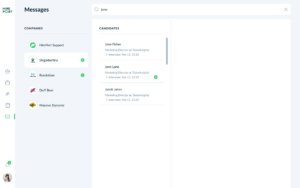Briefing a recruitment agency can be exhausting. You want to give enough info for them to get to work, but not so much that you’re input is overwhelming.
So how to balance it out?
A well-executed briefing isn’t just a formality; it’s the blueprint for your entire recruitment strategy.
Think of it as the GPS that guides your agency through the labyrinth of the job market, directly to your ideal candidate.
Get it wrong, and you’re setting yourself up for a ride full of detours and dead-ends. Get it right, and you’re on the fast track to a successful hire.
So, how do you strike that perfect balance in your briefing? How do you provide just enough information without overwhelming your agency?
Let’s dive into the art and science of nailing your briefing with recruitment agencies.
The art of the briefing
Let’s get one thing straight: a bad briefing is like a bad movie trailer. It either gives away too much or leaves you utterly confused.
So, how do you hit that sweet spot?
1. Be explicit about how you roll
How do you like to work? What channels do you use for communication? What times are you available?
The clearer you are upfront, the smoother the ride will be.
Example: vague vs. clear
Vague Briefing: “Give me a call when you have any questions.”
Sounds simple, right? But you might end up getting calls at all hours, disrupting your workflow and eating into your productivity.
Your recruiter is left guessing when it’s a good time to reach you, and you’re left frustrated by the constant interruptions.
Clear briefing: “I prefer to communicate via email for non-urgent matters and phone calls for urgent ones. I’m generally available for calls between 2 PM and 4 PM. If you have any questions, please compile them and we can address them during our scheduled weekly check-in calls.”
See the difference? In the explicit briefing, you’ve set clear boundaries and expectations.
You’ve specified your preferred communication channels and available times, making it easier for the recruiter to know how and when to reach you. Plus, you’ve set up a system for regular check-ins, so you’re not bombarded with calls and emails throughout the week.
Remember, your recruiting partner is there to save you time and energy, not to keep you from your work continuously. So, be explicit, and make your life a whole lot easier.
Quick win: set boundaries
Don’t want recruiters calling you during your sacred lunch break? Say so. Setting boundaries can save you from unnecessary stress later on.
2. The devil’s in the details
When it comes to describing the job and your company, don’t just skim the surface.
Dive deep. What tools will the candidate use? What’s the team vibe? The more you spill, the better the match will be.
Example: Surface-level vs. deep dive
Surface-level job description: “We’re looking for a software developer familiar with Python to join our dynamic, fast-paced team.”
Okay, cool. But what does that really mean? What will the developer actually do? What’s the team like?
Deep dive job description: “We’re seeking a Python developer who will primarily work on automating data pipelines. You’ll be using tools like Airflow and Docker in a team that values pair programming and code reviews. We have bi-weekly sprints and a monthly ‘Hack Day’ where we explore new technologies. Our team is diverse, with a 50/50 gender split and members from five different countries. We value open communication and have a ‘no-blame’ culture when things go wrong.”
See how the second description paints a much clearer picture? It talks about the specific tools, the team’s working style, and even the team’s composition.
This level of detail helps the recruiter find a candidate who’s not just technically qualified but also a cultural fit.
Quick win: go beyond buzzwords
Ditch the generic terms like “dynamic” and “fast-paced.” Be specific about what makes your company tick.
Example: buzzwords vs. real talk
Buzzword-filled description: “We’re a dynamic, fast-paced, innovative company.”
Real talk description: “We operate in two-week sprints, have a flat organizational structure that encourages employee input, and allocate 10% of work time for learning new skills or working on passion projects.”
The “Real Talk” version gives a recruiter much more to work with.
It’s not just about being “dynamic” or “fast-paced,” it’s about how that actually translates into day-to-day operations and company culture.
3. Culture is real
Your company culture is more than just “open” or “professional.” It’s how you work, play, and interact.
So, give recruiters the inside scoop. Do you have team lunches? Say it. Do you value transparency? Make it known.
Example: vague vs. vivid
Vague culture description: “We have an open and professional culture.”
What does that mean? Open how? Professional in what sense?
Vivid culture description: “We have an open-door policy where anyone can speak to the leadership at any time. We also have ‘Transparency Tuesdays’ where the whole company gathers to discuss business updates and challenges. Our dress code is business casual, but we’re all about ‘Casual Fridays.’ We also have monthly team lunches and quarterly off-site team-building events.”
See the difference? The vivid description gives a recruiter a real sense of what it’s like to work at your company.
It’s not just “open” or “professional”; it’s a living, breathing culture.
Quick win: show, don’t tell
Got a company blog or social media? Share it with recruiters to give them a real feel of your culture.
Example: telling vs. showing
Telling: “We’re a fun-loving team.”
Showing: “Check out our company Instagram where we post behind-the-scenes looks at our team lunches, ‘Hack Days,’ and even our annual ‘Office Olympics.’ You can also read our blog where employees share insights about their roles, projects, and what a typical day looks like for them.”
By showing instead of just telling, you’re giving recruiters a more authentic and tangible sense of your company culture. It’s one thing to say you’re “fun-loving,” it’s another to show it in action.
4. Keep tabs without being a stalker
Regular check-ins are crucial, but nobody likes to be micromanaged.
Schedule these in advance so both parties know what to expect.
Example: The wrong way vs. the right way
The wrong way: “Just keep me updated.”
This is too vague and can lead to either too many updates that feel like stalking or too few updates that make you feel out of the loop.
The right way: “Let’s have a 15-minute catch-up call every Tuesday at 10 a.m. to discuss the progress and any roadblocks. If anything urgent comes up, feel free to send me an email.”
This sets clear expectations and boundaries. It’s not micromanaging; it’s effective communication.
Quick win: use HirePort for centralized communication
Why juggle multiple check-in schedules when you can centralize it all in one place?
Example: The old-school way vs. the HirePort way
The old-school way: Keeping a inbox folder structure for check-ins with multiple agencies. This can get overwhelming, fast.
The HirePort way: Use HirePort’s centralized communication inbox to manage all your communication. You can keep track of previous discussions and updates. All in one place, so no more e-mail overload.
Why HirePort is your briefing wingman (or wingwoman)
With HirePort, you can streamline all your briefings through our chatbox.
Just input your job profile and expectations once, and boom! It’s accessible to all your recruitment agencies plus over 350 HirePort suppliers when needed.
Talk about a time-saver!

Ready to level up your briefing game?
If you’re pumped to make your briefing process as smooth as possible, why not see HirePort in action?
Click the link below to book a demo and discover how we can make your recruitment life a whole lot easier.


